Sindhi Kadhi: A tangy, spicy, and flavorful vegan curry made with a variety of vegetables and gram flour (besan), and is served with rice.
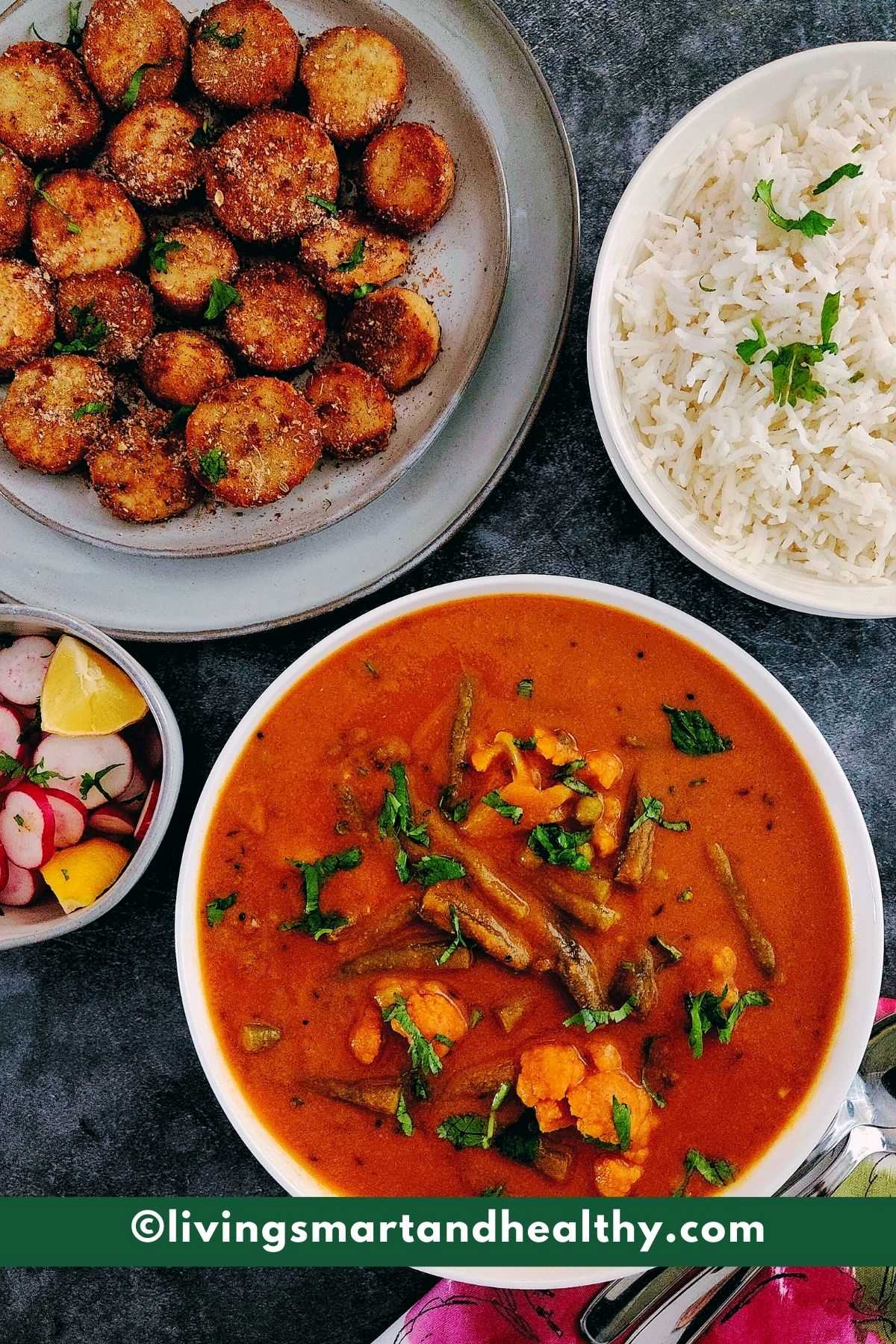
One of the most satisfying and comforting meals, Sindhi Kadhi! A perfect meal for lazy Sunday afternoons.
I remember growing up in India, every Sunday afternoon my mom used to make this kadhi chawal (rice), and aloo tuk for lunch. Oh so delicious, and so comforting!
Our entire family used to get together and we all used to enjoy this meal as a family.
Even today we all look forward to Sunday afternoons, for those special family times and comforting meals.
There are a few ways to make this curry. Today, I am sharing my mom's recipe for this classic Sindhi Kadhi. It's the best vegan curry recipe I have tried so far. My mom makes the Kadhi!!
Jump to:
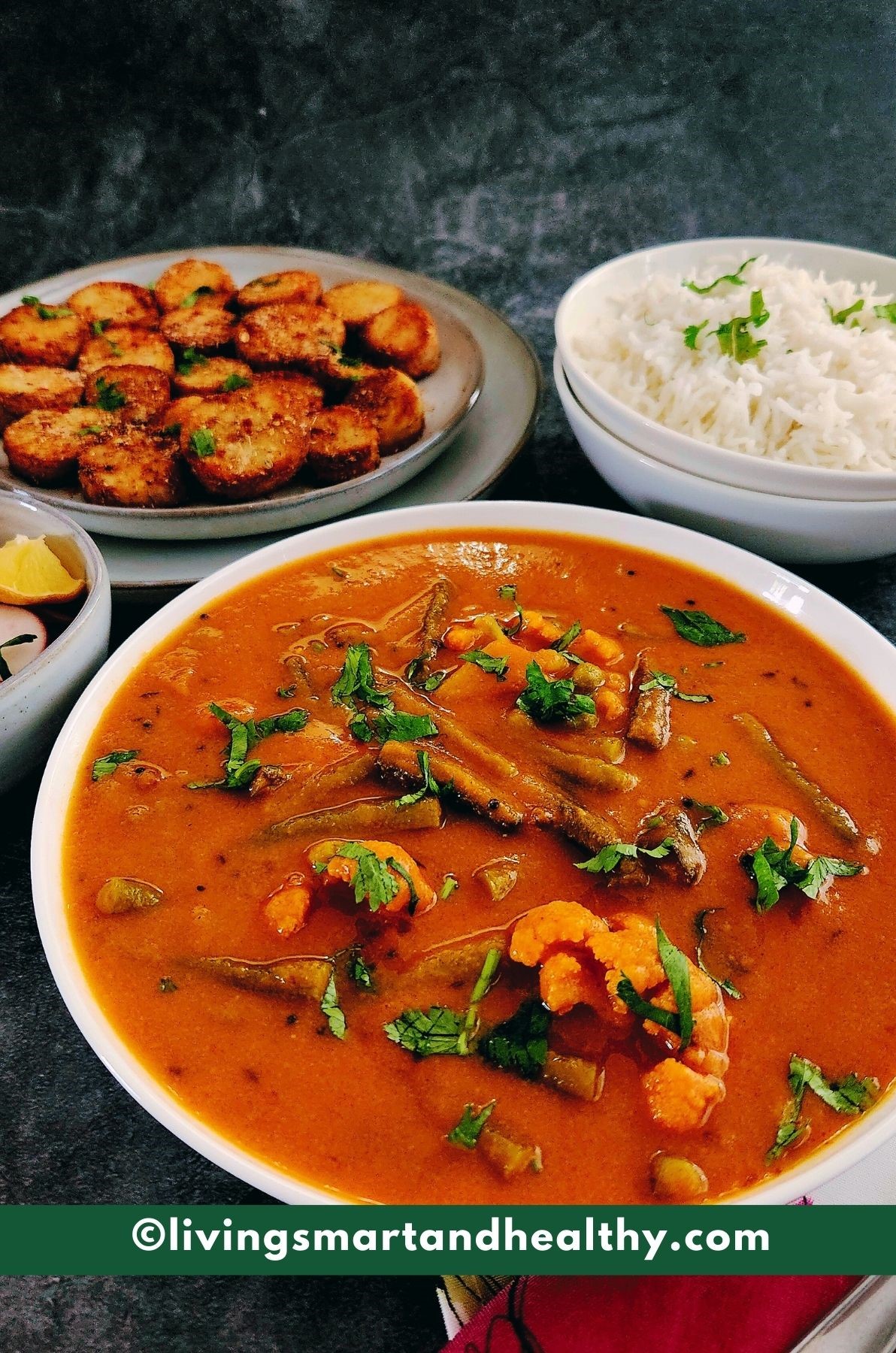
About Sindhi Kadhi | Recipe for Vegan Curry
Flavorful, tangy curry made by roasting chickpeas flour, along with some tomato puree and some Indian spices. Vegetables are simmered in this kadhi until cooked.
The flavors from different vegetables blend in this recipe for vegan curry so amazingly that it is truly one of the BEST dishes!
Typically this dish is served over steamed white rice and some Aloo Tuk (Crispy, smashed, potatoes) or my favorite Arbi Tuk (Crispy Taro Root).
How to Prep Veggies for Curry?
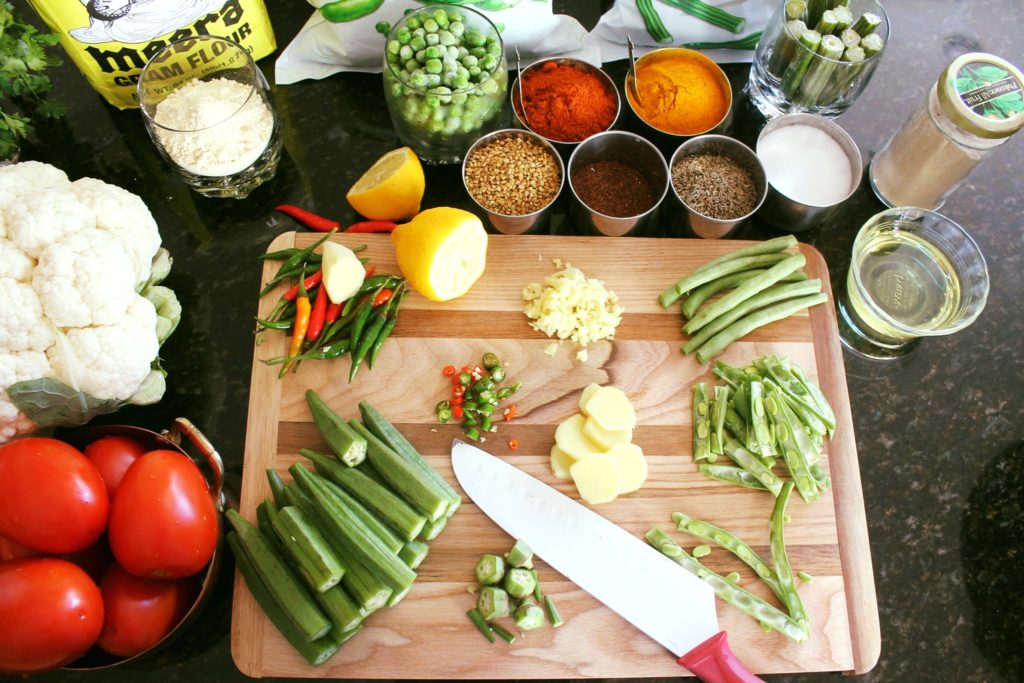
This recipe requires some prep work as we will use a lot of fresh vegetables. The best part of this recipe for vegan curry is that you can use vegetables of your choice. Some of the vegetables that we like in our kadhi are:
Cauliflower - cut the cauliflower into bite-size florets.
Bhindi (Okra) - trim the ends, and slit vertically keeping the okra intact (refer to the pic above)
Green Beans - trim the ends, cut vertically and then into halves (refer to the pic above). Guvar or cluster beans can also be used in place of green beans.
Green Peas - I prefer frozen Indian green peas from Indian/Asian grocery stores. I don't prefer petite peas, as they add sweetness to the kadhi. If using petite peas, reduce the quantity to half.
Vegetable Drumsticks - I prefer frozen drumsticks available in most Indian (Asian) grocery stores.
Ginger - cut into thin slices or coins (optional), adds a nice refreshing taste to the kadhi.
Other vegetables that go well in kadhi are potatoes, yum, lauki or bottle gourd, bhee or lotus roots, sugar snap peas, tindora or ivy gourd.
Sindhi Kadhi Recipe - Video
How to make Sindhi Kadhi?
Let's walk through the step-by-step process of making this yummy recipe for vegan curry. I am making this kadhi in an Instant Pot, however, this recipe can also be made on a stovetop. Use a heavy bottom pot for stovetop cooking.
Step 1: Make Tomato Puree
Tomatoes are a star ingredient in this Sindhi Tomato Kadhi. The fresh tomato puree adds a whole lot of flavor to this kadhi.
I prefer to cook the tomatoes first and later puree them to get a nice silky, smooth texture puree.
The method for making tomato puree is pretty straightforward, using the blanching technique, blanch or boil the tomatoes.
No need to remove the skin of the tomatoes as we will be blending it first and later straining this puree to discard any seeds or tomato skin.
This smooth texture tomato puree is used in the base of recipe for vegan curry, thus giving the kadhi a nice and smooth texture as well as tanginess.
Add tomatoes, and 2 cups of water.
Cover and bring it to a boil. Reduce the heat to medium and cook for 5 mins.
Turn off the heat. Tomatoes are blanched.
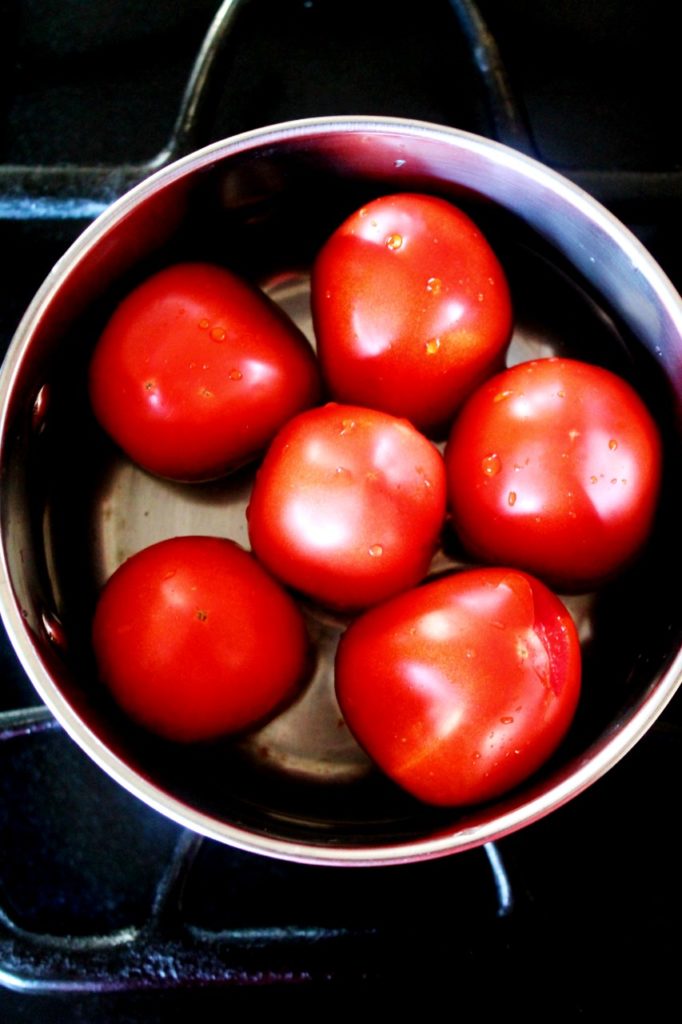
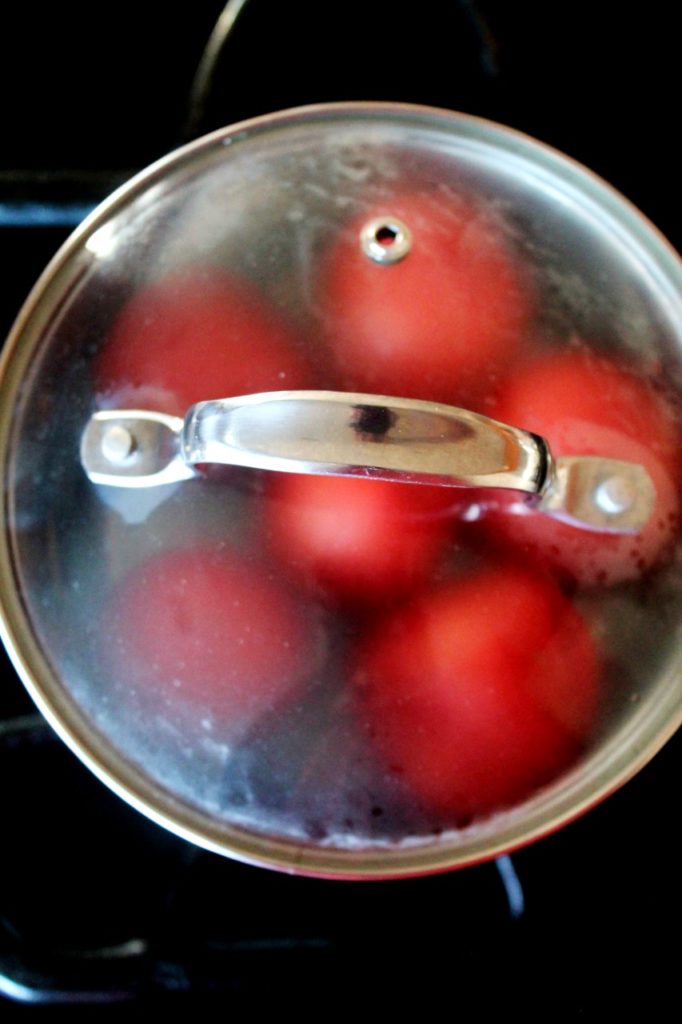
Add tomatoes and the liquid into a blender.
Blend to a smooth puree.
Note: Use EXTREME CAUTION while blending "HOT" liquids. Keep the lid of the blender slightly open to let the hot air escape while blending, to avoid any accidents.
Use a kitchen towel to cover the lid to avoid any splashes. You can also use an immersion blender to puree.
Strain the puree through a fine mesh strainer. Keep the puree aside.
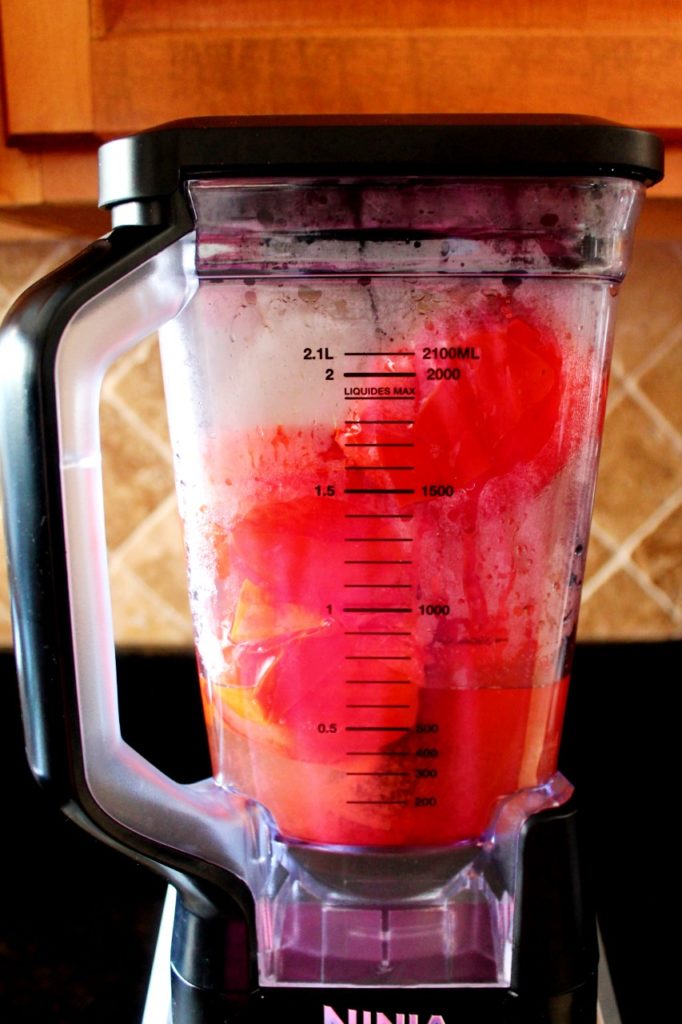
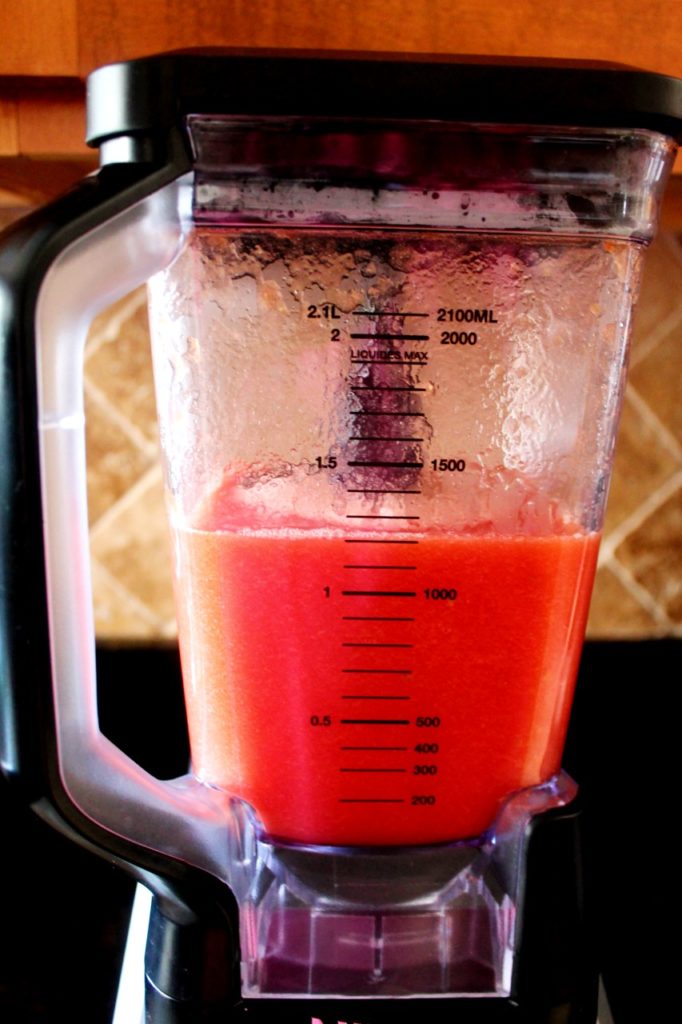
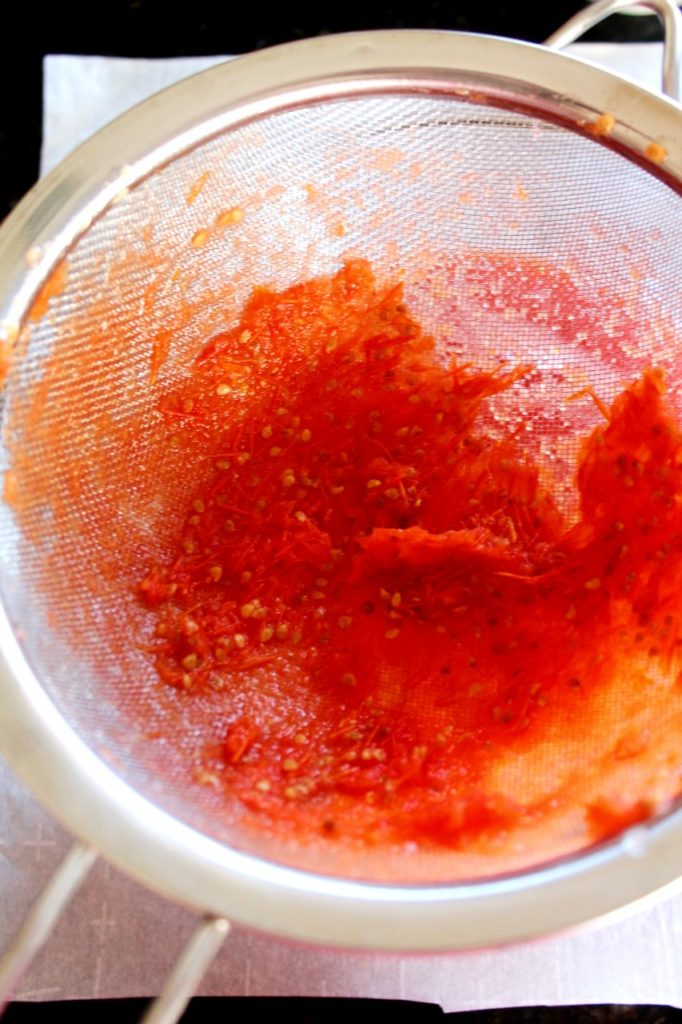
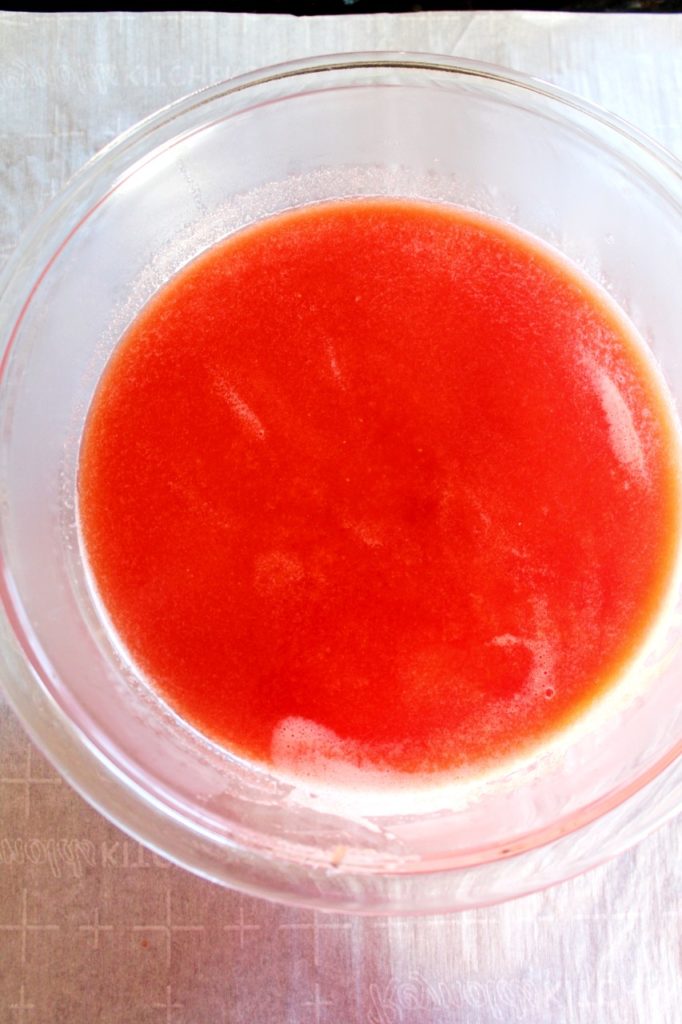
Step 2: Prepare the base of the Curry
This is an important step in making the Sindhi Tomato Kadhi, roasting the chickpeas flour or besan to form the base of this vegan curry.
Roasted chickpea flour or besan turns aromatic and also changes color from pale yellow to brown. Do not leave this step unattended. It takes a few seconds for besan (chickpeas flour) to go from roasted to burnt.
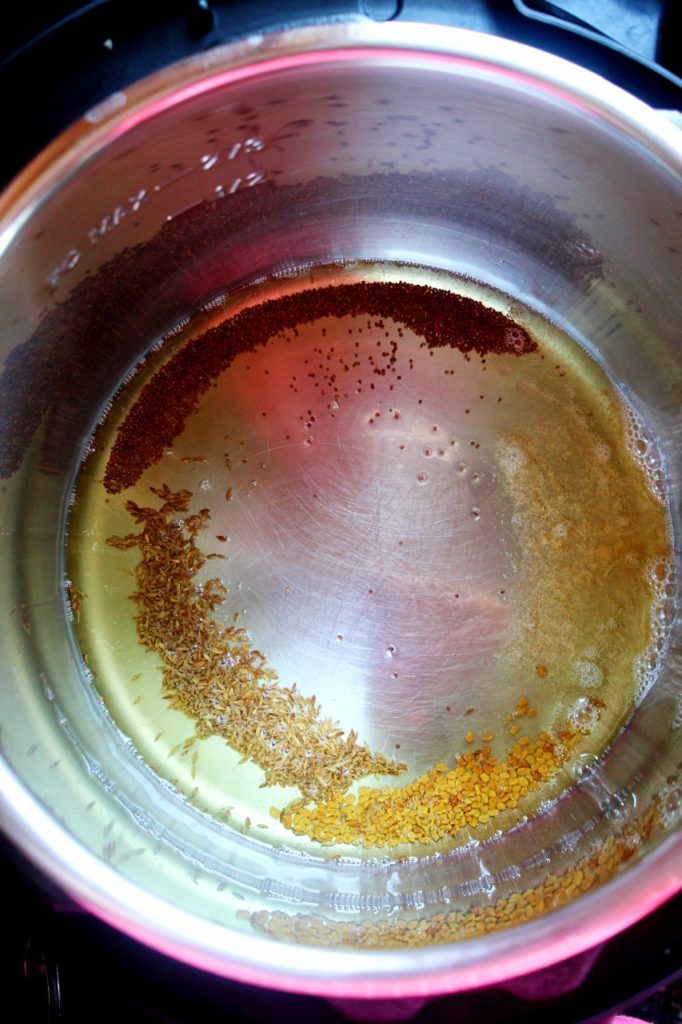
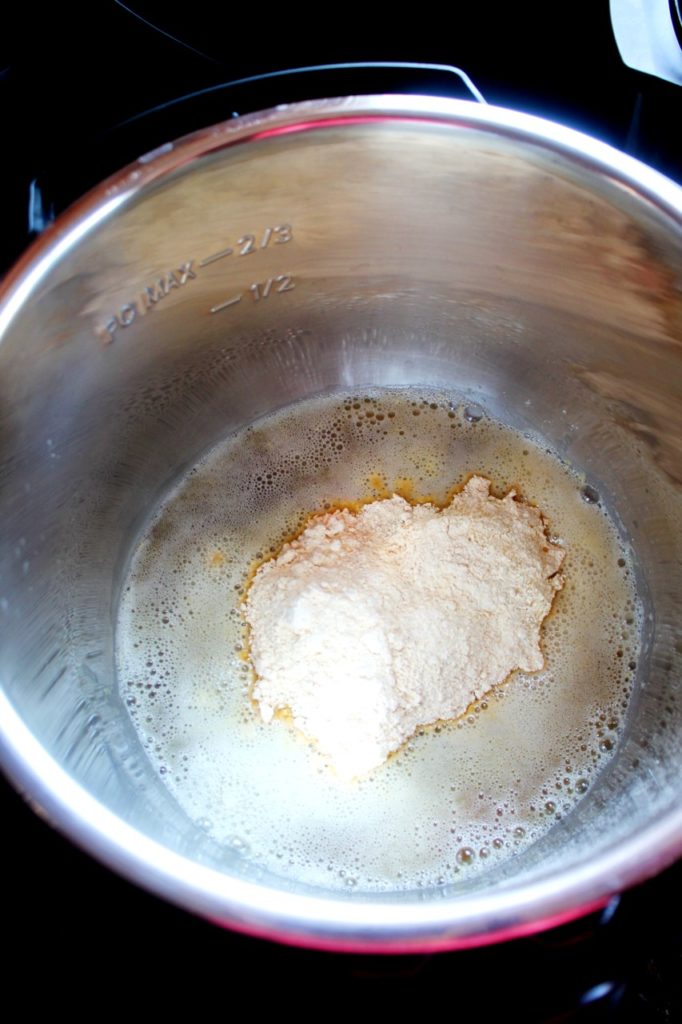
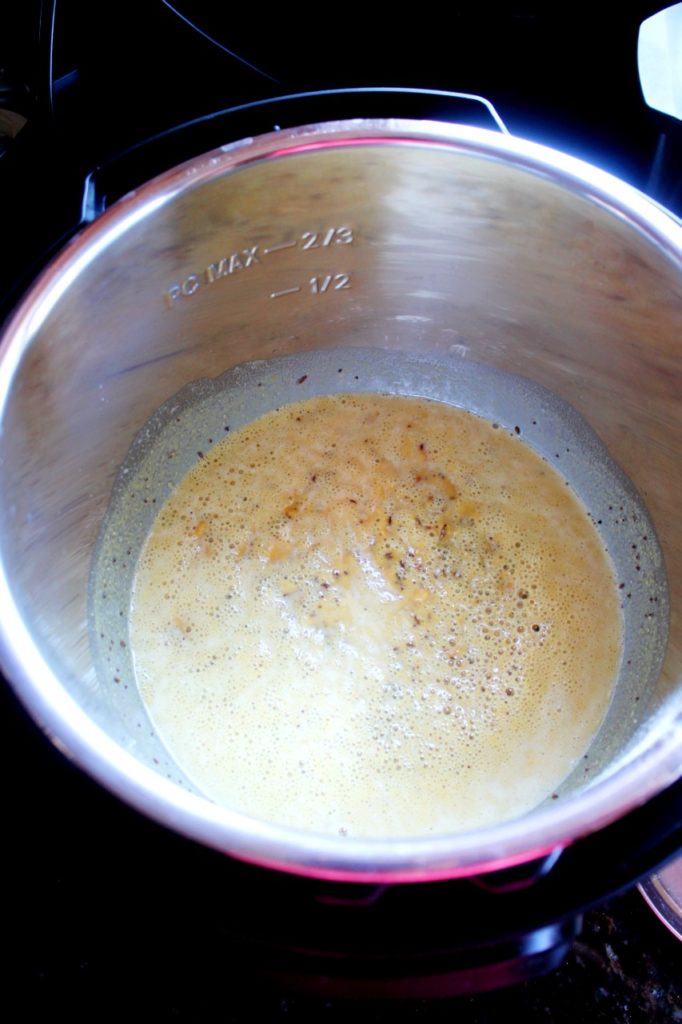
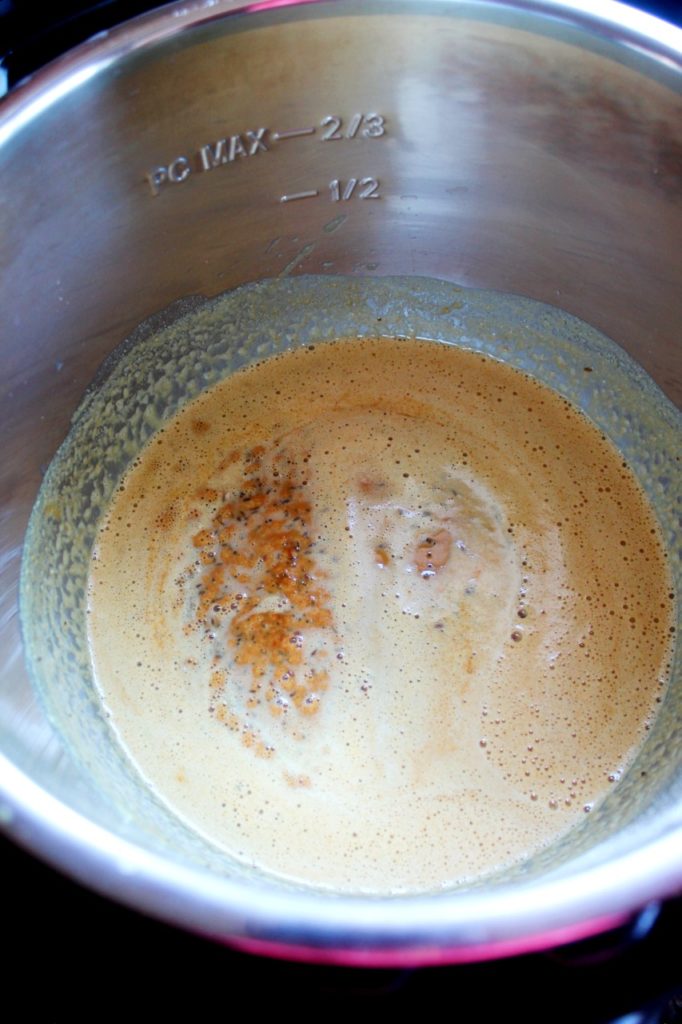
Once the besan or chickpeas flour is nicely roasted, add water and whisk this mixture, making sure there are no lumps.
Add tomato puree (from Step 1), all the spices, and salt to taste, and whisk it again. Close the Instant Pot lid, and vent on sealing.
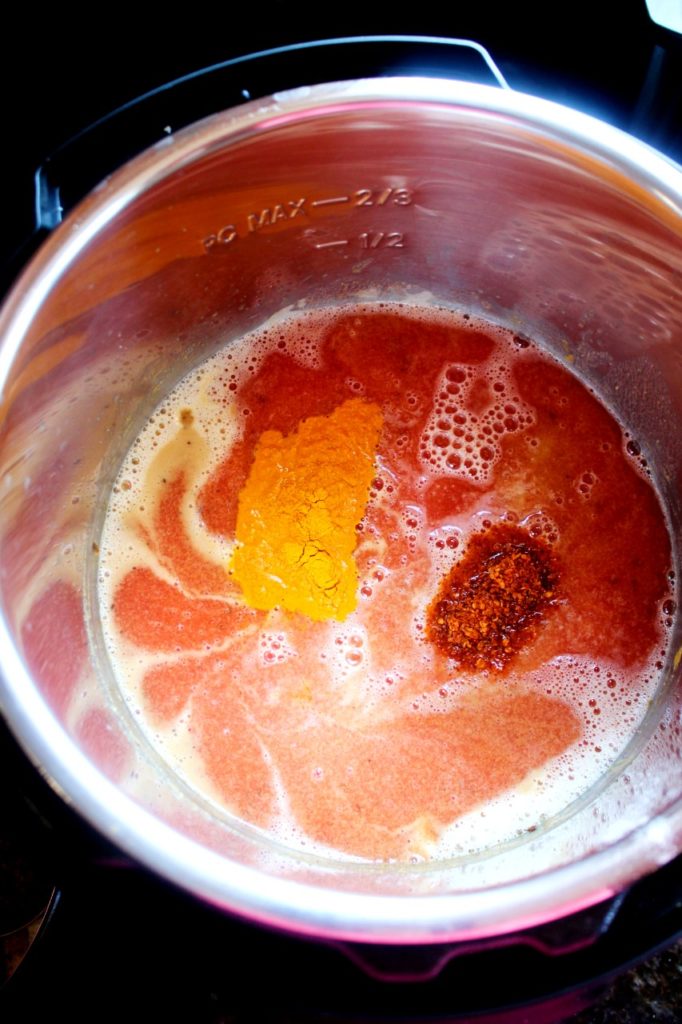
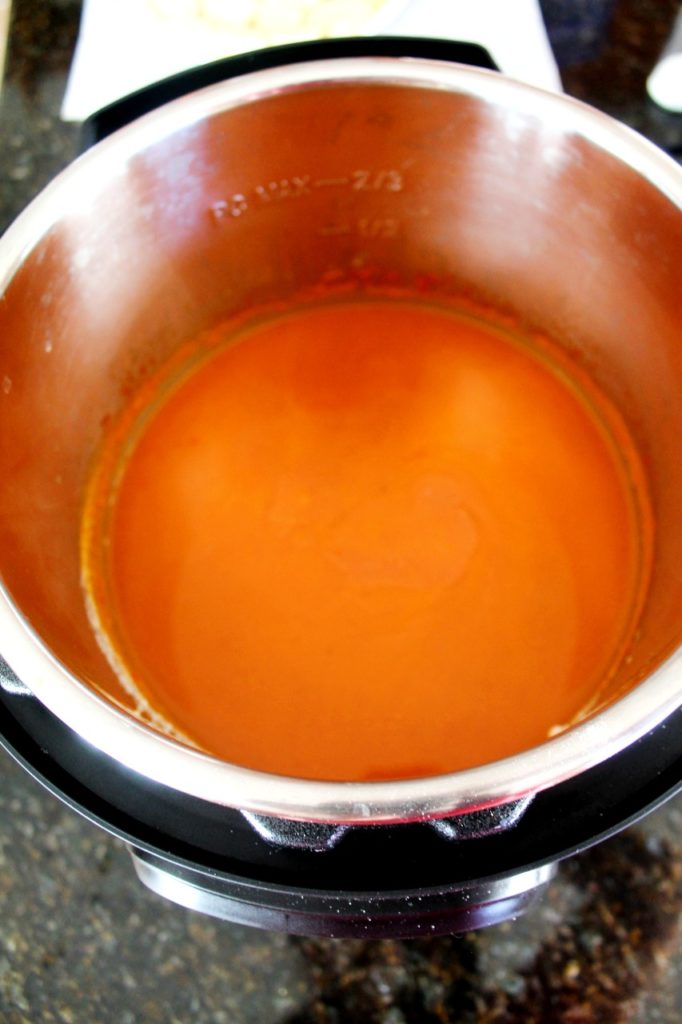
Turn ON soup mode(low) for 15 minutes. Note: Turn OFF the “keep warm” mode.
While the base of the kadhi is in making, you can proceed with Step 3.
Step 3: Cook Vegetables
Drumsticks, okra, and lotus roots, all have different cooking requirements. And therefore I chose to cook these vegetables separately.
Drumsticks when added raw leave a slightly bitter taste in the curry. I prefer to cook the drumsticks separately. Once cooked, drain and keep the drumsticks aside to be added later in the curry.
Bhind (Okra), when added raw to the kadhi, turns slimy or mushy.
Fresh lotus roots take the longest to cook.
For Vegetable Drumsticks
Note: The drumsticks will change color from bright green to pale green color when cooked.
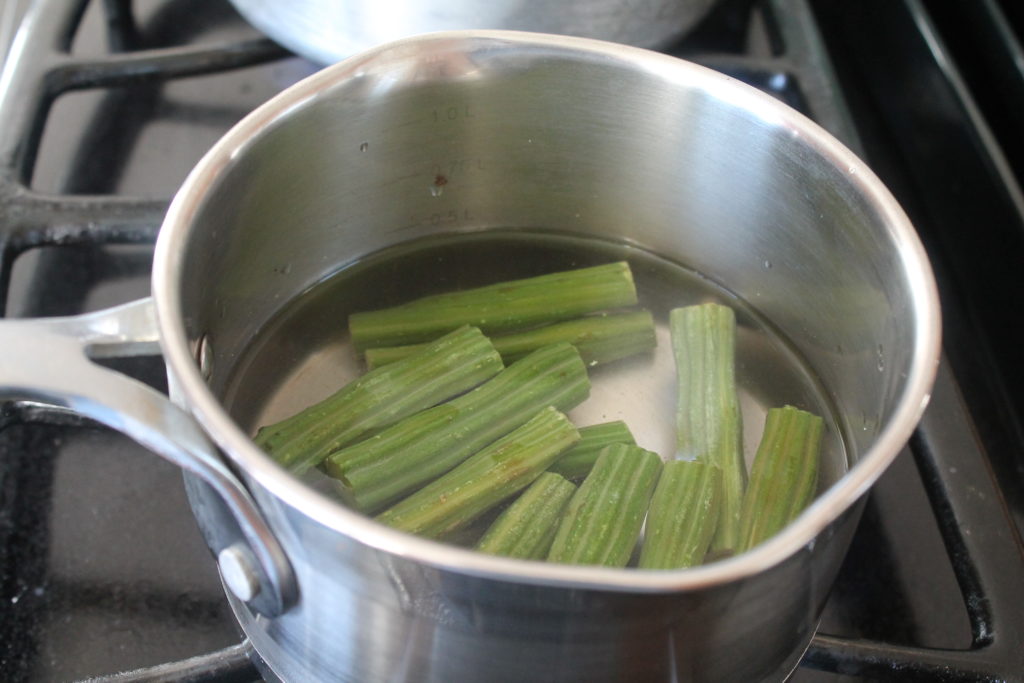
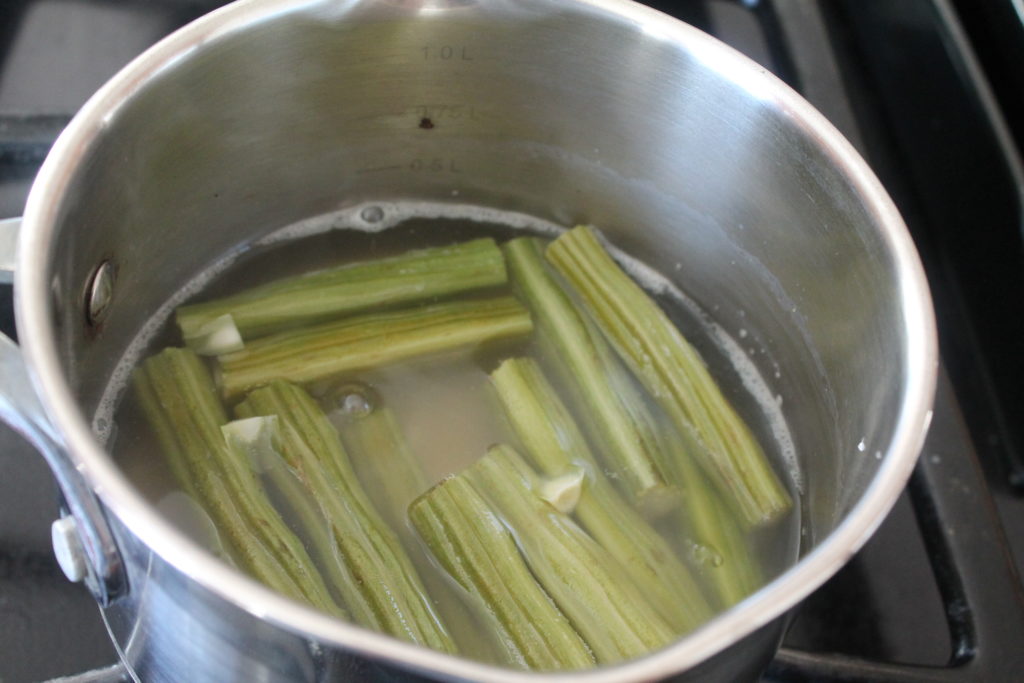
For Bhindi (Okra)
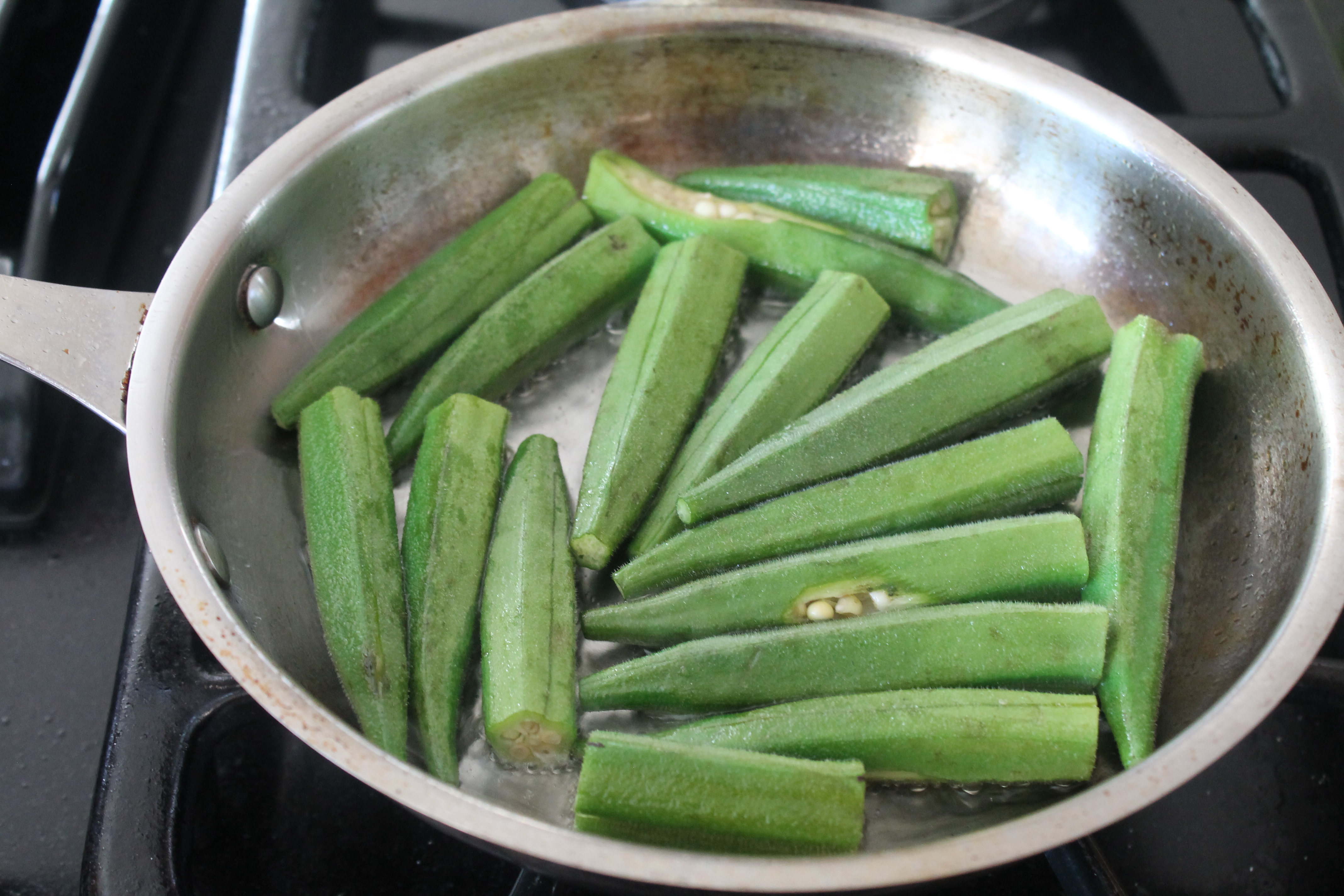
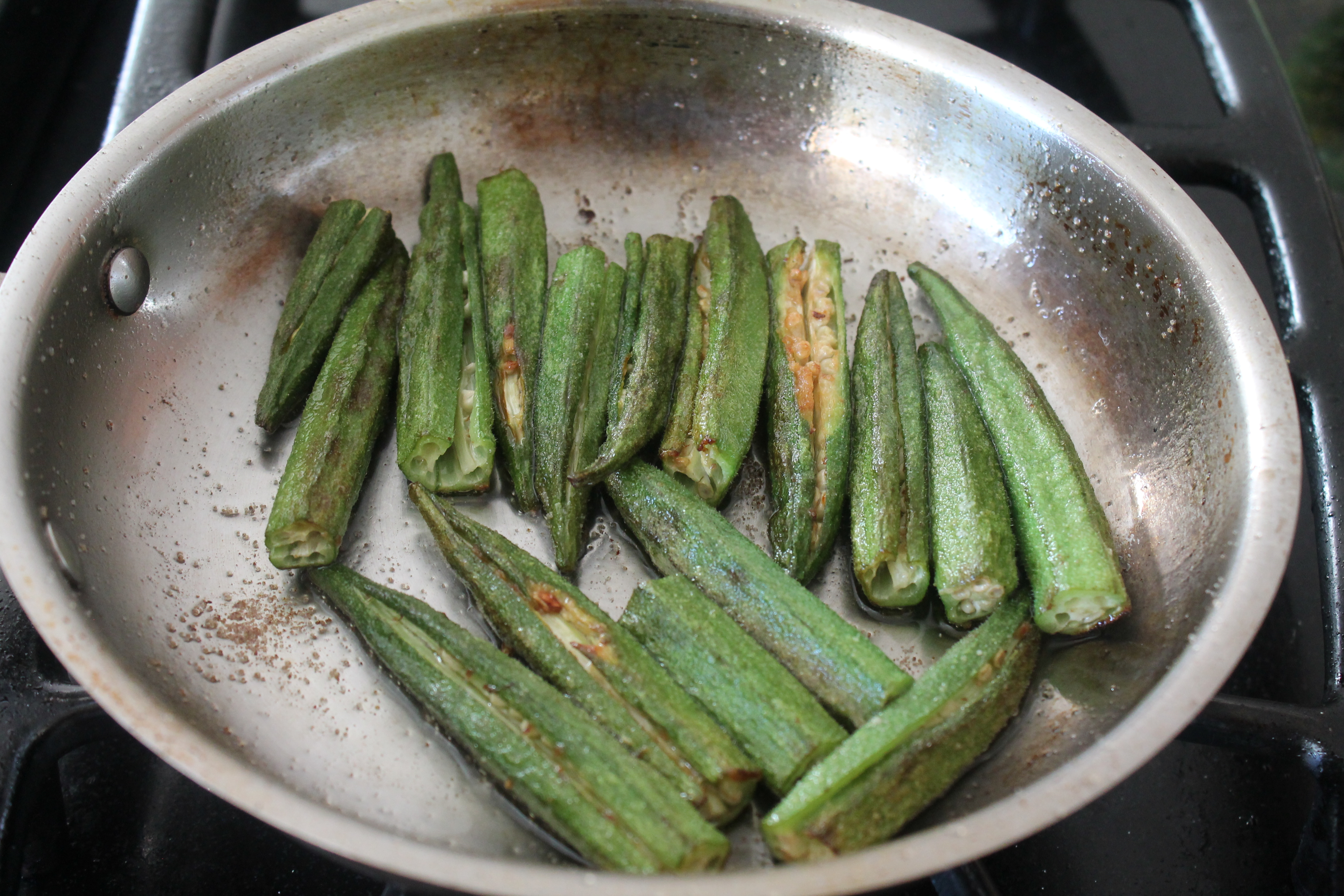
For Bhee (Lotus Root)
If using fresh lotus roots in the curry, these need to be cooked before adding them to the kadhi.
Peel the skin, and cut it into ½ inch thickness, circle, or semi-circle (depending upon the size of the lotus roots).
Boil it with some salt until cooked. Drain the water and use the lotus roots in the kadhi.
You can also use frozen lotus roots available in Indian / Asian supermarkets.
Note: No need to pre-cook the frozen lotus roots just add them with the rest of the vegetables while cooking.
Step 4: Continue with Instant Pot Cooking
Once the base of the kadhi is ready, it's time to add soul to the kadhi - vegetables.
Layering or adding vegetables based on their cooking time is important.
Vegetables that take the longest to cook go in first, followed by ones that take less cooking time.
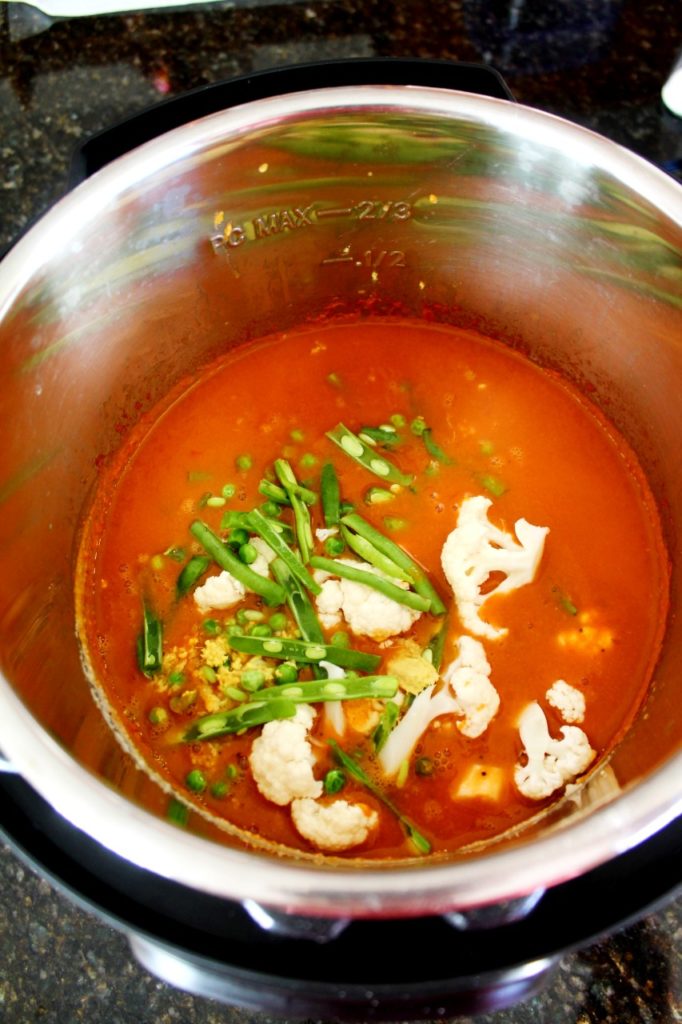
Here's the order in which the vegetables must be added to the kadhi:
Note: The order in which you add vegetables will impact the texture of the veggies. Follow the guideline below for the best results.
- Add the root vegetables first: Vegetables that take longer to cook such as potatoes, yum..., cook the vegetables for a couple of minutes to give them a head start.
- Next add vegetables that require less cooking time: Such as cauliflower, peas, green beans, lauki or bottle gourd, bhee or lotus roots (cooked), sugar snap peas, tindora, or ivy gourd. Cook these vegetables until tender-crisp, but not too soft or mushy.
- Finally, add all the pre-cooked vegetables: Such as drumsticks, okra, or bhindi.
Note: I prefer to cook the okra before adding it to the curry since adding the raw okra makes it very mushy and slimy. Also, I cook drumsticks before adding them to remove any bitter taste from the drumsticks.
Finally, adjust the seasoning. Add lemon juice for more tangy kadhi.
Garnish with some fresh cilantro and serve this delicious kadhi with some steamed white rice and some Aloo Tuk or Arbi Tuk as a side... bon appetit!!!
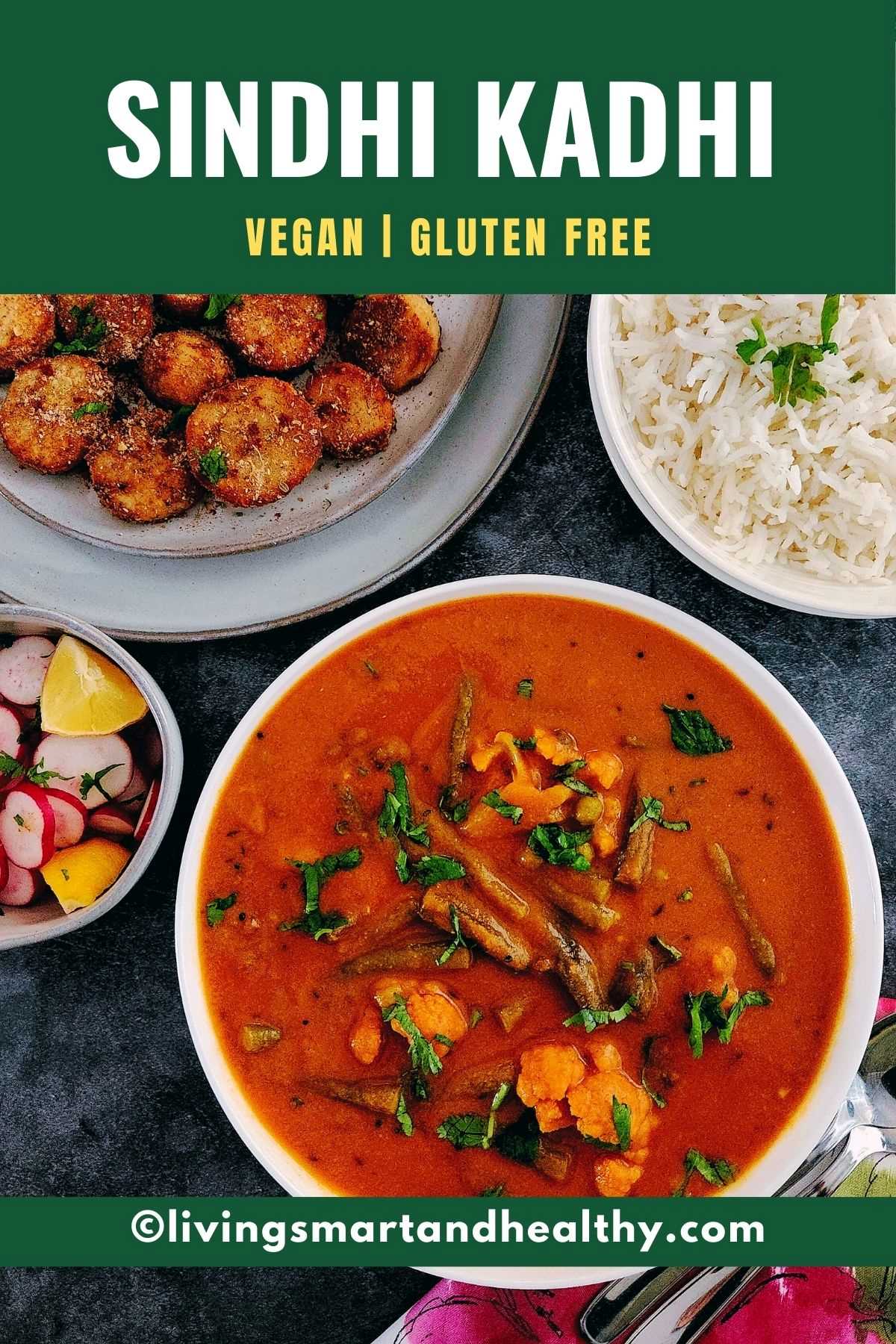
Tips for the Best Sindhi Kadhi
Tomatoes are the star ingredient of this kadhi. I prefer fresh tomatoes, however canned tomato puree may also be used.
Roast the chickpeas flour until slightly brown. Do not leave this step unattended, chickpeas can go from roasted to burnt in no time.
The order in which you add vegetables will impact the texture of the veggies. For best results add all the vegetables as suggested:
Add the root vegetables first. Root vegetables such as potatoes, yum…, take longer to cook than others. Therefore, cook these vegetables for a couple of minutes before adding any other vegetables.
Next add vegetables that require less cooking time such as cauliflower, peas, green beans, lauki or bottle gourd, bhee or lotus roots (cooked), sugar snap peas, tindora, or ivy gourd. Cook these vegetables until tender-crisp, but not too soft or mushy.
And finally, add all the pre-cooked vegetables such as drumsticks, okra, or bhindi.
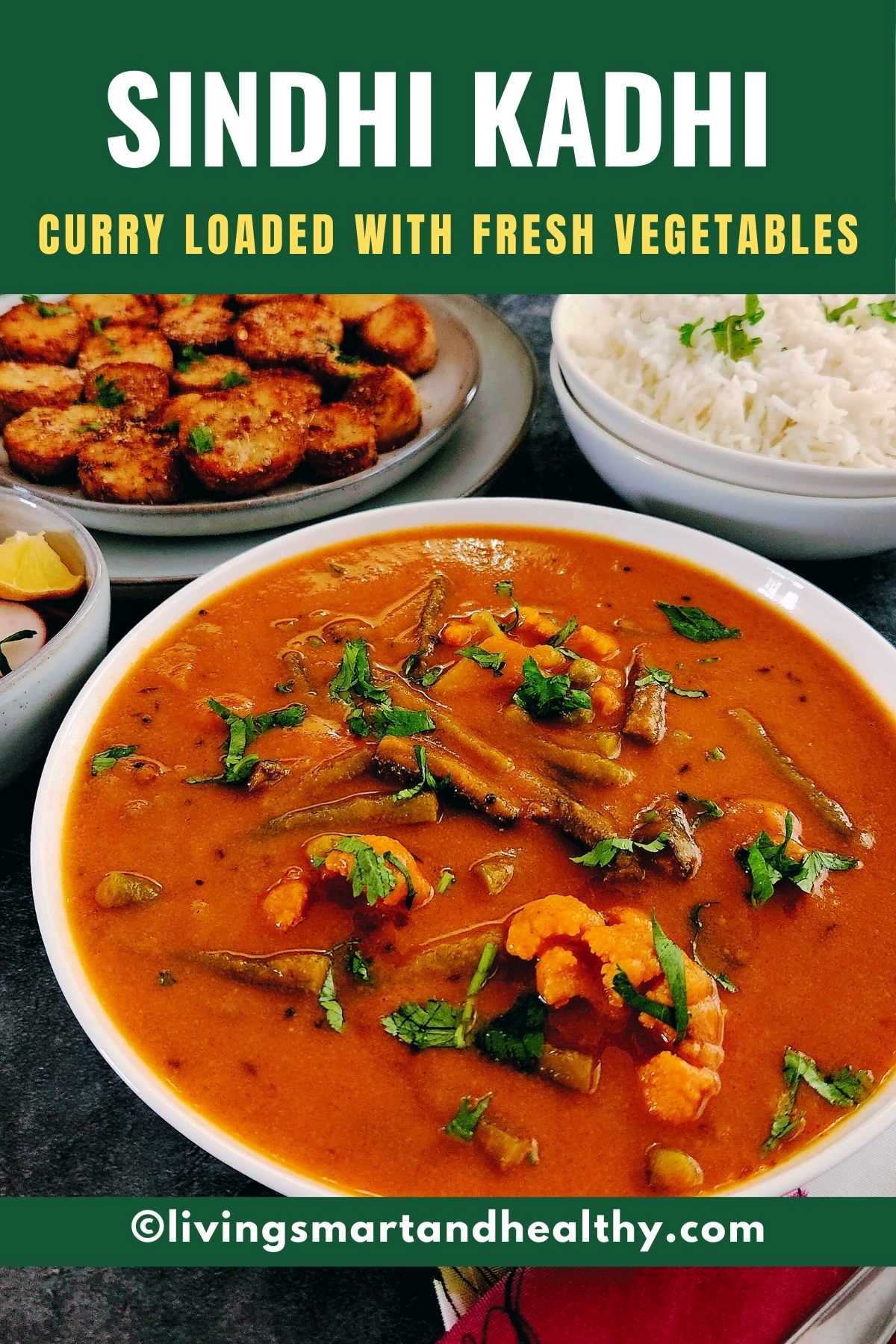
Tips for the Best Sindhi Kadhi (Continued)
Cook drumsticks, okra, and lotus roots, before adding them to the kadhi. These vegetables have different cooking requirements.
Raw drumsticks when added to the kadhi, leave a slightly bitter taste in the kadhi. So, it is best to pre-cook these vegetable drumsticks separately. Once cooked, drain and keep the drumsticks aside and add them at the end.
Raw okra or bhindi when added to the kadhi, it turns slimy or mushy. Therefore, pre-cook this bhindi separately and add it at the end.
Fresh lotus roots take the longest to cook. Pre-cook and add it to the kadhi at the end.
You can also use frozen lotus roots available in Indian / Asian supermarkets. However, no need to pre-cook the frozen lotus roots just add them with the rest of the vegetables while cooking.
I prefer frozen Indian green peas. If using petite peas, reduce the quantity to half.
You can also use tamarind pulp or lemon used to make kadhi tangier.
More Sindhi Recipes
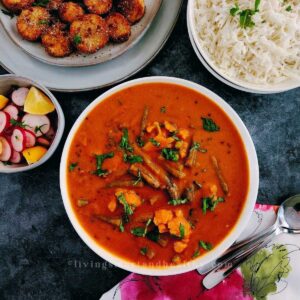
Sindhi Kadhi | Vegan Curry with Vegetables
Equipment
Ingredients
- 6 medium tomatoes
- 10-12 gobi , (cauliflower florets)
- 12-14 bhindi , (okra)
- ½ cup matar , (green peas) fresh or frozen
- 12-14 green beans
- 12-14 Vegetable Drumsticks
- ½ inch ginger , chopped
- 2 green chili , chopped, as per taste
- 2 inch ginger , coins (optional), slice into circle or coins, around 5-6 pieces
- ½ cup oil
- 6 cups water ,divided (2 cups + 2 cups + 2 cups)
Dry Ingredients:
- ½ cup besan ,(chickpea flour)
- 1 teaspoon turmeric powder
- 1 teaspoon red chili powder
- salt to taste
- ½ teaspoon rai , (mustard seeds)
- 1 teaspoon jeera , (cumin seeds)
- ½ teaspoon methi dana , (fenugreek seeds)
- ⅛ teaspoon hing , (asafetida)
For Garnish:
- Fresh coriander, chopped
- 1 lemon , juice, as per taste
Instructions
Step 1: Make Tomato puree
- In a sauce pan, add tomatoes, 2 cups of water.
- Cover and bring it to a boil. Reduce the heat to medium and cook for 5 minutes.
- Turn off the heat.
- Add tomatoes and the liquid into a blender. Note: Use EXTREME CAUTION while blending "HOT" liquids. Keep the lid of the blender slightly open to let the hot air escape while blending, to avoid any accidents. Use a kitchen towel to cover the lid to avoid any splashes. You can also use immersion blender to puree.
- Blend to a smooth puree.
- Strain the puree through a fine mesh strainer. Keep the puree aside.
Step 2: Prepare the Base of the Kadhi
- Turn on Instant Pot ON saute mode (high), when it displays "HOT", add oil, mustard seeds, wait for seeds to crackle, now add cumin seeds, fenugreek seeds, asafoetida, saute for 15 seconds.
- Add besan / chickpea flour, saute until flour changes color from pale yellow to brown in color. Saute for around 5-7 minutes. Keep sauteing every 30 - 60 seconds, to prevent besan / chickpea flour from getting burnt.Note: This is a important step, do not leave this step unattended. It takes few seconds for besan / chickpea flour to go from roasted to burnt.
- After sauteing the besan for 5-7 minutes, you will see change in color from pale yellow to brown. Also the besan will be much lighter and smoother.
- Add 2 cups of water, tomato puree, turmeric, red chili powder, salt to taste. Whisk this mixture, make sure there are no lumps.
- Turn OFF saute mode. Close the Instant Pot lid, vent on sealing. Turn ON soup mode(low) for 15 minutes.Note: Turn OFF the "keep warm" mode. While the base of the kadhi is in making, proceed with STEP 3.
Step 3: Cook Vegetables
- Add drumsticks to pan, add water to cover the drumsticks and ⅛ teaspoon of salt, bring it to a boil.
- Reduce the heat and cook until the drumsticks are cooked, around 5-7 minutes.
- Turn off the heat. Keep the drumsticks aside.Note: The drumsticks will change color from bright green to pale green color when cooked.
For Okra / bhindi:
- Heat a kadai or a pan, add 2-3 tablespoon of oil.
- Add okra / bhindi and cook on medium heat until almost cooked, around 5-7 minutes.
- Turn off the heat. Keep the okra aside.
Step 4: Continue with Instant Pot cooking
- After 10 minutes of natural pressure release, manually release the remaining pressure. Open Instant Pot, turn ON saute mode (high).
- Add 2 cups of water. Mix well. Cover with a lid and bring the kadhi to a rolling boil.
- Add all the veggies (except okra and drumsticks) - cauliflower, green beans, green peas, ginger coins, ginger chopped, green chili. Note: Do not add okra and drumsticks at this stage.
- Cover with a lid and bring the kadhi to a boil.
- Uncover and cook until veggies are tender - crisp but not mushy, around 3-5 minutes.
- Finally, add okra and drumsticks. Adjust the seasoning. Add lemon juice for more tangy kadhi. Cook for 2-3 minutes, turn OFF Instant Pot.
- Garnish with some fresh cilantro and serve this kadhi with some steamed white rice. Enjoy!
Notes
- Use EXTREME CAUTION when blending HOT liquids to avoid any accidents. Follow manufacturers recommended instructions when using kitchen appliances.
- Please checkout the post for details and all the PRO tips to make the BEST Sindhi Tomato kadhi.
- Adjust seasoning salt+red chili as per taste. Add lemon juice depending upon how tangy you like the kadhi.
- The consistency of the kadhi thickens as it cools down. Adjust the consistency of the kadhi by adding more water if required.
- How to prep veggies - please refer to How to prep veggies discussed earlier in the post.
- What other veggies can be added to the kadhi - please refer to How to prep veggies discussed earlier in the post.
- For stove top cooking, follow the same instructions as discussed in the recipe. Bring the base of the kadhi to a rolling boil, reduce the heat to medium- low and simmer the kadhi for 15-20 minutes, stirring occasionally to prevent any overflowing of the kadhi. Rest of the steps remain the same as Instant Pot. Note: Use a dutch oven or heavy bottom pot (around 8 qt).
- This recipe was created in Instant Pot Duo, 8 quarts.
Nutrition
Disclaimer
Nutrition values are my best estimates. If you rely on them for your diet, use your preferred nutrition calculator.

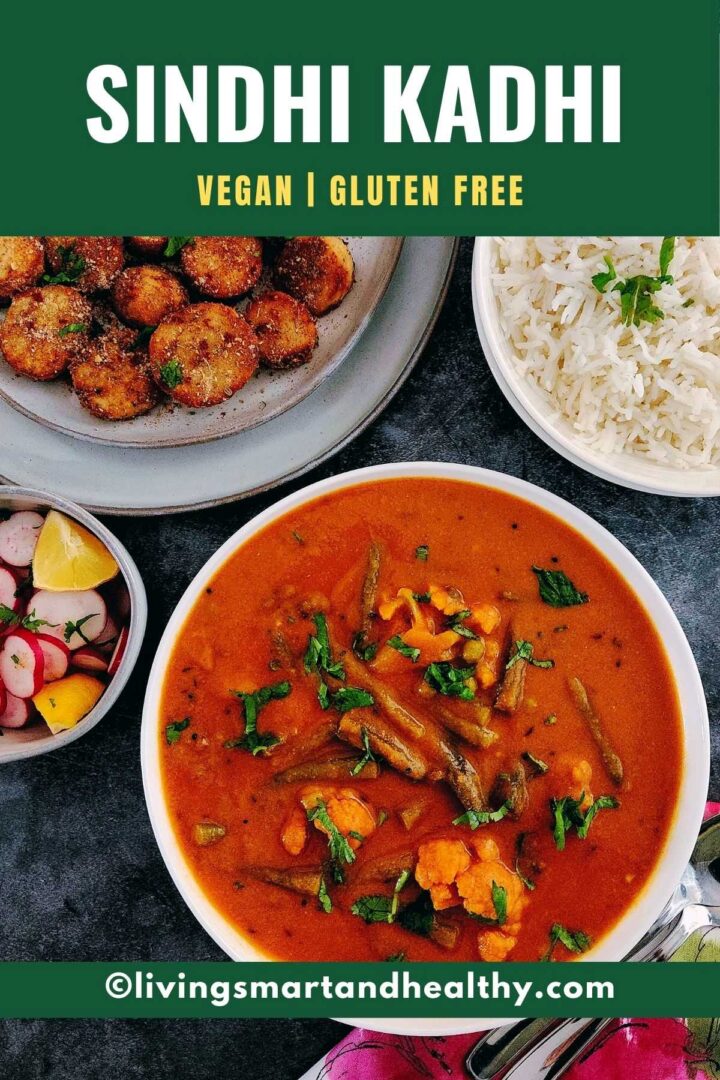
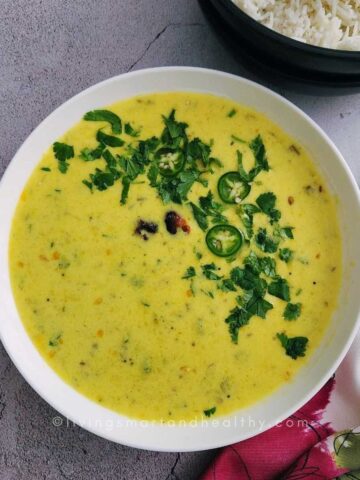

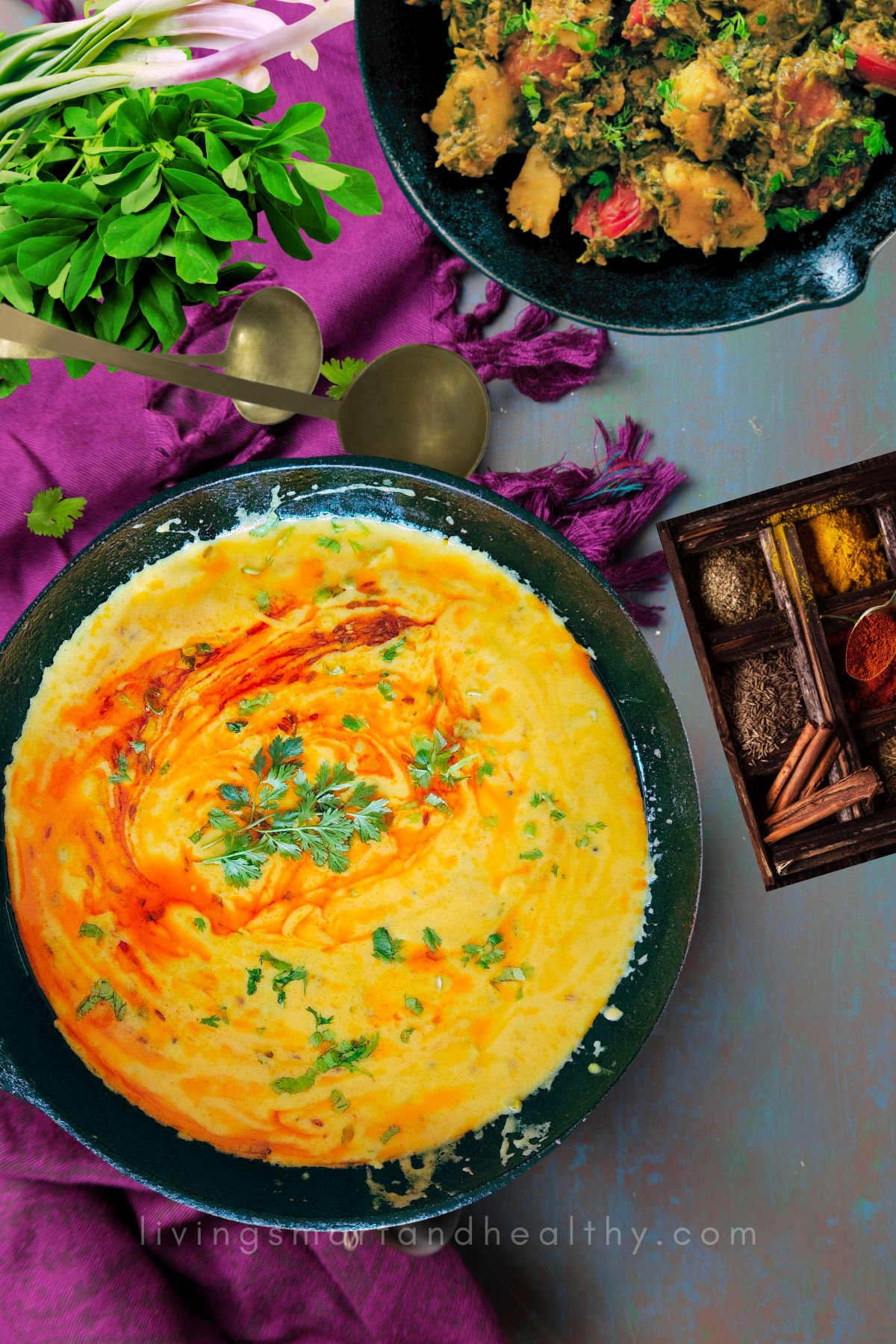
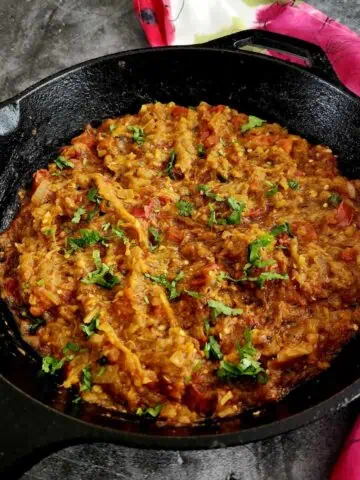


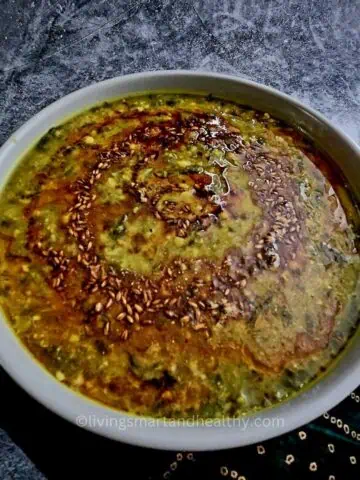
Deepa Israni says
Very nice recipe. Clearly explained
Jyoti Behrani says
I am so glad you liked the recipe. Thank you.